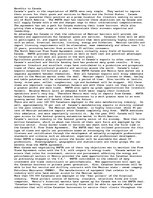1n 1991, more than one hundred and thirty five thousand Canadians were employed by the textiles and apparel industry, mostly in Montreal, Toronto and Winnipeg. The NAFTA sets out strict rules of origin for most yarns, fabric and clothing. These new levels will help Canadian textile and apparel manufacturers expand their exports of products to the profitable U.S. market. With the NAFTA, Canadian and Mexican tariffs on apparel will be eliminated within 10 years. Many might worry in Canada and query if this is really an advantage for Canada. Arguably it really doesn't affect Canada because Mexican apparel is geared to cheaper, lower quality products. While the Canadian industry is moving toward producing higher value textiles and quality designer fashions.
The North American Free Trade Agreement has 'streamlined' transportation between the three countries involved. Within six years, trucks and buses can crisscross the North American continent with virtually no border restrictions. Under NAFTA, for instance, a Canadian driver can take a load from Calgary, to Mexico city, with a stop in Texas for more goods. And on the way home, the same driver can deliver Mexican goods to both Canadian and U.S. destinations. This freedom of movement will increase the efficiency of our land carriers and will also enhance the competitiveness of our goods.
…



